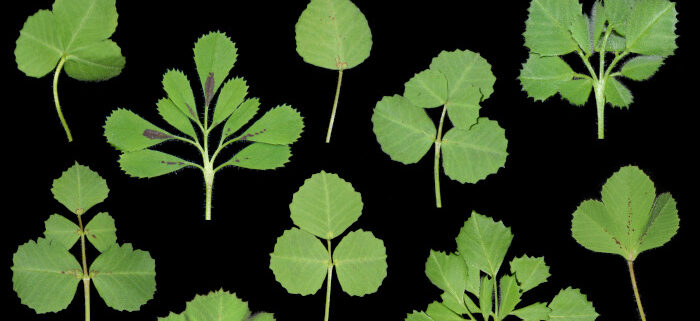Regulation of leaflet number in compound leaves
He et al. investigate the molecular mechanisms of compound leaf formation in Medicago truncatula
By Liangliang He and Jianghua Chen
https://doi.org/10.1093/plcell/koae033
Background: In the plant kingdom, leaves have different shapes, with the most noticeable difference being between simple and compound leaves. Simple leaves have a single blade, while compound leaves are made up of multiple leaflets, displaying higher complexity and diversity in form. From a developmental perspective, compound leaves are initiated as simple primordia at the flanks of the shoot apical meristem (SAM), which subsequently undergo a series of coordinated morphogenetic events to develop into a complex structure with multiple leaflets. The two most important events of this process are leaflet initiation and boundary formation. Understanding the molecular mechanisms underlying and integrating these events is of particular interest.
Question: What are the molecular mechanisms responsible for regulating and integrating these intricate developmental processes during compound leaf development?
Findings: Here, we characterized a pinnate leaf-pattern mutant pinnate-like pentafoliata2 (pinna2) in Medicago truncatula, phenotypically resembling the previously reported pinna1 mutant. Through map-based cloning, we identified the PINNA2 gene encoding a GRAS transcription factor. PINNA2 is specifically expressed at organ boundaries, including the SAM-to-organ and leaflet-to-leaflet boundaries. The PINNA2 protein directly binds to the promoter of SGL1, which encodes a leaflet initiation positive regulator, to repress its transcription. Furthermore, PINNA2 works together with two other transcription factors, PINNA1 and PALM1, to repress SGL1 expression in different leaf domains, thereby ensuring accurate leaf morphogenesis. Additionally, the expression of PINNA2 at leaflet boundaries is positively regulated by a boundary-specific protein NAM/CUC, which is crucial for leaflet boundary formation. These findings provide molecular insights into the regulation and integration of intricate developmental processes during compound leaf development.
Next steps: Future studies will focus on defining the roles and relationships of PINNA1, PINNA2, PALM1, SGL1, MtNAM and other regulators at cellular and deeper molecular levels. Additionally, we plan to apply these genes to molecular breeding in alfalfa using gene editing techniques.
Reference:
Liangliang He, Ye Liu, Yawen Mao, Xinyuan Wu, Xiaoling Zheng, Weiyue Zhao, Xiaoyu Mo, Ruoruo Wang, Qinq Wu, Dongfa Wang, Youhan Li, Yuanfan Yang, Quanzi Bai, Xiaojia Zhang, Shaoli Zhou, Baolin Zhao, Changning Liu, Yu Liu, Million Tadege, Jianghua Chen (2024). GRAS transcription factor PINNATE-LIKE PENTAFOLIATA2 controls compound leaf morphogenesis in Medicago truncatula. https://doi.org/10.1093/plcell/koae033




